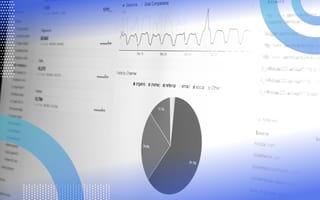Web analytics are used by almost every industry as a crucial lever to improve business outcomes, which is why we can find web analytics on over 86 percent of the world’s top 50,000 websites.
Web analytics has been around for almost 30 years — almost as long as the web itself. In the early days, web analytics simply provided basic traffic insights like how many people visited a certain page. Since then, it has burgeoned into a rich ecosystem of metrics allowing companies to see user behavior in ever-increasing detail.
What Is the Web Analytics Process?
- Set business goals
- Collect data
- Process data
- Report data
- Develop a strategy
- Experiment and test
What Are the Main Types of Web Analytics?
There are two broad categories of web analytics: on-site analytics and off-site analytics.
On-Site Analytics
On-site analytics covers user actions on a business’s website. This includes general insights into website page views, page interactions and more generally, user behavior.
Off-Site Analytics
Off-site analytics is exactly that, analytics on all the web traffic that is not the business’s website. This includes search engine optimization (SEO) research to increase a business’s web search ranking, market research with Google Trends to understand general web trends and social media analysis with platforms like Twitter, Facebook and TikTok.
Web Analytics Process
The process of producing web analytics requires many processes and a wide array of skills. Software engineers, data engineers and data scientists all work together to build out web analytics systems.
The data collection step is primarily realized through embedded JavaScript code on websites. This JavaScript can track actions taken by users including button clicks, typing and view tracking. The system then transforms raw data into metrics, such as time spent on the site or the number of sales.
Using these metrics, data professionals can then build analytics. Some examples include product conversion funnels to dive deep into customer purchasing behavior and mouse-tracking heatmaps to understand user’s interests.
A/B testing is one of the essential functions that’s come out of web analytics. With an A/B test, product teams can compute the impact of the changes they make to a website. For example, if they want to change the color of a button from red to blue, they can show blue to one set of users while the remaining users see red. They can then compare behavior between the two separate groups to determine whether the button had a positive effect or not. Metrics considered usually include sales, clicks and time spent on site.
Why Are Web Analytics Important?
Web analytics have a wide range of applications from marketing to product optimization. In all cases, web analytics allow businesses to make decisions based on data as opposed to user research or gut feeling. A survey by BARC found that companies were able to increase revenue by an average of eight percent through the analysis of big data (including web analytics), while reducing costs by up to 10 percent — and that was back in 2015.
Web Analytics Tools
There are a variety of software applications to make running web analytics simple. The most popular ones include Google Analytics, Mixpanel and Adobe Analytics. These applications provide a full measurement framework including code to begin tracking users across a website, data storage and processing, as well as visualization tools. They are great options for any small companies looking to start doing web analytics. Large companies will typically build out their own web analytics tools in order to have more flexibility.
What Are the Risks of Web Analytics?
The main concerns around web analytics come from misuse of data. There has been mounting concern that companies have been using data in ways that they’re not supposed to, which in turn negatively affects people.
Probably the most notable examples of this are issues around user privacy. In particular, organizations such as Google, Meta and Microsoft collect large amounts of web data to drive their advertising businesses. Companies then use this data to profile users and allow advertisers to target specific groups. This benefits the advertiser who can make more sales with less of their advertising budget. However, users are not always aware that their information is being shared and it may make them uncomfortable.
There are notable events such as Facebook’s U.S. election scandal, in which foreign actors used the power of web analytics to manipulate the 2016 U.S. election. Another common web analytics scandal is a data breach, such as the Yahoo data breach in 2013, in which Yahoo leaked data from three billion user’s accounts.





